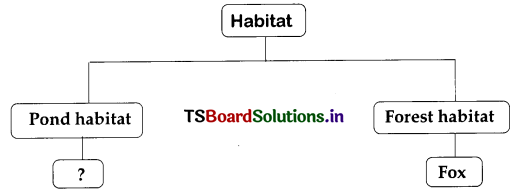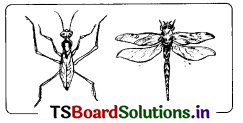Regular practice with TS 6th Class Science Bits with Answers 6th Lesson Habitat improves students’ confidence and readiness for assessments and examinations.
TS 6th Class Science Bits 6th Lesson Habitat
Question 1.
Components of a habitat
A) temperature
B) moisture
C) shelter
D) above all
Answer:
D) above all
![]()
Question 2.
AIl habitats are grouped into
A) terrestrial
B) aquatic
C) A and B
D) air habitat
Answer:
C) A and B
Question 3
Habitats show the of nature.
A) environment
B) plants
C) animals
D) diversity
Answer:
D) diversity
Question 4.
Our intestine is a habit at for
A) several animals
B) several microbes
C) several plants
D) none of the above
Answer:
B) several microbes
![]()
Question 5.
One of the following is a reptile
A) Wolf
B) Parrot
C) Garden Lizard
D) House fly
Answer:
C) Garden Lizard
Question 6.
An example that belongs to aquatic habitat is
A) hydrill
B) vallisneria
C) lotus
D) all
Answer:
D) all
Question 7.
Organism that lives in the bottom of the pond is
A) fis
B) lotus
C) hydrilla
D) whirling beetle
Answer:
C) hydrilla
Question 8.
Desert animal
A) Rat
B) Camel
C) Horse
D) Cow
Answer:
B) Camel
![]()
Question 9.
Organism lives in underground
A) Cat
B) Earthworm
C) Hen
D) Dog
Answer:
B) Earthworm
Question 10
Identify the plant which float on the surface of the pond.
1) Hydrilla
2) Pistia
3) Lotus
4) Vallisneria
A) 1,2,3
B) 2,3
C) 3
D) 2
Answer:
D) 2
![]()
Question 11.
Identify the plant which is not a hydrophyte (water plant)
A) Hydrilla
B) Tulasi (Holy basil)
C) Lotus
D) Vallisneria
Answer:
B) Tulasi (Holy basil)
Question 12.
In the following which belongs to desert habitat?
A) elephant
B) horse
C) camel
D) lion
Answer:
C) camel
Question 13.
An example of terrestrial habitat
A) forest
B) pond
C) sea
D) river
Answer:
A) forest
Question 14.
……………. is the suitable place for cockroaches.
A) Wet and dark
B) Dry and dark
C) Wet and light
D) A and B
Answer:
B) Dry and dark
Question 15.
Which of the following is a desert plant?
A) Cactus
B) Acaria
C) Aloevera
D) All of these
Answer:
D) All of these
![]()
Question 16.
The birds and animals take temporary habitat in our school during midday meal
A) Crow
B) Dog
C) House-flies
D) All
Answer:
D) All
Question 17.
Identify desert plant
A) Cactus and Aloevera
B) Neem and Teakwood
C) Mango
D) Apple and Guava
Answer:
A) Cactus and Aloevera
Question 18.
Ozone day is celebrated on
A) September -16
B) October -16
C) November -16
D) December -16
Answer:
A) September -16
Question 19.
Birds from Siberia come to Kolleru lake. This is
A) Change of habitat for laying eggs
B) Distance from hunters
C) For maintaining ecological balance
D) To entertain visitors
Answer:
A) Change of habitat for laying eggs
Question 20.
All habitats on land collectively known as
A) Desert habitat
B) Terrestrial habitat
C) Aquatic habitat
D) Forest habitat
Answer:
B) Terrestrial habitat
![]()
Question 21.
Hydrilla plant grows
A) on water
B) on the land
C) in water
D) at any place
Answer:
C) in water
Question 22.
The plants that are grown in our house.
A) Peepal
B) Tamarind
C) Neem
D) Crotan
Answer:
A) Peepal
Question 23.
The following plants need less water.
A) Desert plants
B) Water plants
C) Terrestrial plants
D) Garden plants.
Answer:
A) Desert plants
Question 24.
Example of aquatic plant.
A) Hydrilla
B) Hydra
C) Rose
D) Hibiscus
Answer:
A) Hydrilla
Question 25.
Read the following sentences.
a) In orchards, farmers grow a single type of fruit plants.
b) In a mango orchards different types of trees can be grown.
A) both a and b are true
B) a is true, b is false
C) a is false, b is true
D) both a and b are false
Answer:
B) a is true, b is false
Question 26.
The animal that lives on both terrestrial and aquatic habitats
A) Bird
B) Frog
C) Leech
D) Fish
Answer:
B) Frog
![]()
Question 27.
This is not an aquatic habitat
A) lake
B) canal
C) river
D) desert
Answer:
D) desert
Question 28.
If pond habitat is destroyed
A) fish will die
B) birds will die
C) insects disappear
D) trees will die
Answer:
A) fish will die
Question 29.
This is not a pet animal
A) Cow
B) Dog
C) Tiger
D) Cat
Answer:
C) Tiger
Question 30.
Identify the odd one.
A) Hydrilla
B) Lotus
C) Vallisnaria
D) Tamarind
Answer:
D) Tamarind
![]()
Question 31.
Identify the plant which is different from other plants.
A) Aloevera
B) Opuntia
C) Vallisnaria
D) Cactus
Answer:
C) Vallisnaria
Question 32.
If we disturb the habitat of any organism what would happen?
A) Organism will die
B) It will impact other organisms in the habitat
C) No change will occur
D) All the organisms will be happy
Answer:
B) It will impact other organisms in the habitat
Question 33.
The components of a habitat are
A) air
B) water and food
C) shelter
D) all the above
Answer:
D) all the above
Question 34.
Hydrilla plants are formed in habitat.
A) sand
B) tree
C) aquatic
D) desert
Answer:
C) aquatic
![]()
Question 35.
If you want to create habitat for birds what would you do?
A) growing trees
B) cutting trees
C) sowing trees
D) killing trees
Answer:
A) growing trees
Read the paragraph and answer the questions (36- 38).
The plants that grow ¡n coastal regions differ from those of Telangana or Rayalaseema.
Question 36.
What will you understand from the above sentence?
A) Difference in states
B) Difference in plants
C) Diversity of habitat
D) Diversity of land
Answer:
C) Diversity of habitat
Question 37.
Battameka pitta is seen in district.
A) Krishna
B) Kurnool
C) Vizag
D) Hyderabad
Answer:
B) Kurnool
![]()
Question 38.
We can see mangroves only in districts
A) coastal
B) deccan
C) mountain
D) desert
Answer:
A) coastal
Question 39.
During the months of October to March birds like appear near Kolleru lake.
A) Pelican
B) Peacocks
C) Sparrows
D) Vultures
Answer:
A) Pelican
Question 40.
Identify the animal belongs to pond habitat.

A) Lion
B) Crow
C) Fish
D) Elephant
Answer:
C) Fish
Question 41.
Identify the given diagrams.
A) Cockroach; Dragonfly
B) Dragon fly; House fly
C) House fly; Cockroach
D) Pond skater; Dragonfly
Answer:
D) Pond skater; Dragonfly
![]()
Question 42.
Identify the given plant.
A) Pistia
B) Lotus
C) Ichornia
D) Hydrilla
Answer:
A) Pistia
Question 43.
Interdependency of organisms is disappearing due to
A) Industrialisation
B) Pollution
C) Man made activities
D) Any one of the above
Answer:
C) Man made activities
Question 44.
All the desert animals can adjust in any dry habitat. Can a human being adjust?

A) Yes
B) No
C) Can’t say
D) Yes / No
Answer:
B) No
Question 45.
A beautiful habit at

A) An orchand
B) Dry land
C) Dumping yard
D) B and C
Answer:
A) An orchand
Question 46.
The barks bear green velvety growth that are seen in
A) Summer season
B) Autumn season
C) Rainy season
D) Dry condition
Answer:
C) Rainy season
Question 47.
……………. is voluntary organisation to work for animal rights and protection
A) Red Cross
B) Green Cross
C) Blue Cross
D) All
Answer:
C) Blue Cross
![]()
Question 48.
Good example for diversity of habItat
A) Grapes grown in Telangana and Andhra
B) Apples grown in Kashmiî but not in A.P.
C) Lions are seen all over India.
D) Buttameka pitta is in all the states.
Answer:
B) Apples grown in Kashmiî but not in A.P.
Question 49.
Unharmed habit at leads to
A) better war
B) better food searching
C) unfavourable life
D) better life
Answer:
D) better life
Question 50.
| Parts | Terrestrial plant (Tulasi) | Aquatic plant (Hydrilla) |
| Stem Leaf |
hard flattened |
Slender ? |
A) Scaly
B) Large
C) Hard
D) Long
Answer:
A) Scaly